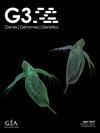鉴定芽殖酵母中的 BioID 标记系统并探索 Ccr4-Not 复合物的相互作用组
IF 2.1
3区 生物学
Q3 GENETICS & HEREDITY
引用次数: 0
摘要
改良大肠杆菌生物素连接酶 BirA* 是第一个开发用于蛋白质近距离标记(BioID)的生物素连接酶。然而,它在 37˚C 以下的温度下活性较低,这降低了它在较低温度下生长的生物(如萌芽酵母)中的有效性。目前已经设计出了多种酶的衍生物,但对这些生物素连接酶的变体进行全面比较,并开发出在酿酒酵母中进行这些实验的多功能工具,将使社区受益匪浅。在这里,我们设计了一套载体来比较生物素连接酶在酵母中的活性。我们发现,较新的 TurboID 版本在标记蛋白质方面最有效,但由于培养基中含有生物素,即使在没有外源生物素的情况下,它们对蛋白质的持续标记率也很低。我们描述了一种在细胞中表达游离生物标记酶的简单策略,这种策略可用作生物标记研究中的适当对照,以解释细胞中诱饵-生物标记酶之间随机相互作用造成的蛋白质杂乱标记。我们还描述了利用雷帕霉素稳定的 FRB-FKBP 相互作用的化学诱导 BioID 系统。最后,我们使用 TurboID 版本的酶来探索 Ccr4-Not 基因调控复合物不同亚基的相互作用组。我们发现,Ccr4-Not 主要标记细胞质 mRNA 调控因子,这与它在该细胞区的 mRNA 衰减和翻译质量控制中的功能一致。本文章由计算机程序翻译,如有差异,请以英文原文为准。
Characterization of BioID tagging systems in budding yeast and exploring the interactome of the Ccr4-Not complex
The modified E. coli biotin ligase BirA* was the first developed for proximity labeling of proteins (BioID). However, it has low activity at temperatures below 37˚C, which reduces its effectiveness in organisms growing at lower temperatures, such as budding yeast. Multiple derivatives of the enzymes have been engineered, but a thorough comparison of these variations of biotin ligases and the development of versatile tools for conducting these experiments in Saccharomyces cerevisiae would benefit the community. Here, we designed a suite of vectors to compare the activities of biotin ligase enzymes in yeast. We found that the newer TurboID versions were the most effective at labeling proteins, but they displayed low constitutive labeling of proteins even in the absence of exogenous biotin, due to biotin contained in the culture medium. We describe a simple strategy to express free BioID enzymes in cells that can be used as an appropriate control in BioID studies to account for the promiscuous labeling of proteins caused by random interactions between bait-BioID enzymes in cells. We also describe chemically-induced BioID systems exploiting the rapamycin-stabilized FRB-FKBP interaction. Finally, we used the TurboID version of the enzyme to explore the interactome of different subunits of the Ccr4-Not gene regulatory complex. We find that Ccr4-Not predominantly labeled cytoplasmic mRNA regulators, consistent with its function in mRNA decay and translation quality control in this cell compartment.
求助全文
通过发布文献求助,成功后即可免费获取论文全文。
去求助
来源期刊

G3: Genes|Genomes|Genetics
GENETICS & HEREDITY-
CiteScore
5.10
自引率
3.80%
发文量
305
审稿时长
3-8 weeks
期刊介绍:
G3: Genes, Genomes, Genetics provides a forum for the publication of high‐quality foundational research, particularly research that generates useful genetic and genomic information such as genome maps, single gene studies, genome‐wide association and QTL studies, as well as genome reports, mutant screens, and advances in methods and technology. The Editorial Board of G3 believes that rapid dissemination of these data is the necessary foundation for analysis that leads to mechanistic insights.
G3, published by the Genetics Society of America, meets the critical and growing need of the genetics community for rapid review and publication of important results in all areas of genetics. G3 offers the opportunity to publish the puzzling finding or to present unpublished results that may not have been submitted for review and publication due to a perceived lack of a potential high-impact finding. G3 has earned the DOAJ Seal, which is a mark of certification for open access journals, awarded by DOAJ to journals that achieve a high level of openness, adhere to Best Practice and high publishing standards.
 求助内容:
求助内容: 应助结果提醒方式:
应助结果提醒方式:


